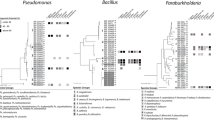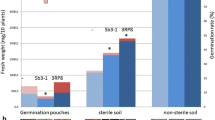Abstract
An avirulent strain ofPseudomonas solanacearum, B82, was tested for its ability to protect the potato cultivar, Ontario, from bacterial wilt caused by virulent strains of this bacterium. Strain B82 was not antagonistic to 124 virulent strains ofP. solanacearum and was not bacteriocinogenic. When potato seedpieces were soaked for 5 hr in suspensions of B82 (108 to 109 cfu/ml), reduction in disease severity (up to 50%) was noted in some experiments. The treated plants, grown in the greenhouse or growth room for 4–5 wk, were challenged by stem inoculation, soil drenching, or root-to-root infection with virulent strains (276 or Br5) of the bacterium. Protection was not obtained consistently, however, and much of the variability could be attributed to differences in ambient temperature and light conditions in the greenhouse between experiments. In general, high ambient temperatures and/or reduced sunlight resulted in no protection. Protection appeared to depend on the ability of strain B82 to multiply in the vascular system in the crown region and to colonize the rhizosphere of treated plants. Soil temperatures above 24 C affected the ability of strain B82 to survive in the rhizosphere. The close dependence of protection on environmental conditions suggests that this method of control may not be practical under field conditions.
Compendio
Una cepa no virulenta dePseudomonas solanacearum, B82, se utilizó en pruebas de control biológico del marchitamiento bacteriano de la variedad de papa, Ontario, y que es causado por cepas virulentas de esta misma bacteria. La cepa B82 no es antagónica y no produce bacteriocinas contra 124 cepas virulentas deP. solanacearum. Cuando se sumergieron pedazos de tuberculos por 5 horas en una suspensión de B82 (108 a 109 bacterias/ml), hubo una reducción en la severidad de la enfermedad hasta del 50% en las plantas que crecieron de estos tubérculos en el invernadero o en fitotrones. Las plantas fueron inoculadas después de 4–5 semanas con cepas virulentas (Br5 o 276) ya sea por punción del tallo, aplicación de la bacteria directamente al suelo, o infección por contacto directo de raíz a raíz. Sin embargo, no se obtuvo protección de las plantas en forma consistente, aparentemente debido al efecto pronunciado de diferencias en condiciones ambientales entre un experimento y otro, especialmente las de temperatura y luz. En general, altas temperaturas y luz reducida eliminaron el efecto protector del tratamiento con bacterias. La protectión parece depender de la habilidad de la cepa B82 de multiplicarse en el sistema vascular de la planta y de colonizar la superficie de las raíces de las plantas tratadas. Las temperaturas del suelo arriba de 24°C afectaron la supervivencia de la cepa B82 en la superficie de las raíces. La dependencia estricta de la protección a las condiciones ambientales indica que el tratamiento de tubérculos con la cepa B82 posiblemente no sea práctico como control biológico bajo condiciones de campo.
Similar content being viewed by others
Literature Cited
Averre, C.W. and A. Kelman. 1964. Severity of bacterial wilt as influenced by the ratio of virulent to avirulent cells ofPseudomonas solanacearum in inoculum. Phytopathology 54:779–783.
Bowman, J.E. and L. Sequeira. 1982. Resistance toPseudomonas solanacearum in potato: infectivity titrations in relation to multiplication and spread of the pathogen. Am Potato J 59:155–164.
Chen, W.Y. and E. Echandi. 1981. Protection of tobacco plants from bacterial wilt with avirulent bacteriocin-producing strains ofPseudomonas solanacearum. pp. 482–492.In: Proc Fifth Intl Conf Plant Path Bacteria, Cali, Colombia. (J.C. Lozano, Ed.). 640 pp.
Chen, W.Y. and E. Echandi. 1982. Bacteriocin production and a semiselective medium for detection, isolation, and quantification ofPseudomonas solanacearum in soil. Phytopathology 72:310–313.
Chen, W.Y. and E. Echandi. 1984. Effects of avirulent bacteriocin-producing strains ofPseudomonas solanacearum on the control of bacterial wilt of tobacco. Plant Pathol 33:245–253.
Cuppels, D.A. and A. Kelman. 1974. Evaluation of selective media for isolation of softrot bacteria from soil and plant tissue. Phytopathology 64:468–475.
Cuppels, D.A. 1976. Bacteriocin production byPseudomonas solanacearum. Ph.D. Thesis, University of Wisconsin, Madison. 135 pp.
French, E.R. and L. de Lindo. 1982. Resistance toPseudomonas solanacearum in potato: Specificity and temperature sensitivity. Phytopathology 72:1408–1412.
Gallegly, M.E. and J.C. Walker. 1949. Relation of environmental factors to bacterial wilt of tomatoes. Phytopathology 39:936–946.
Granada, G.A. and L. Sequeira. 1983. A new selective medium forPseudomonas solanacearum. Plant Dis 67:1084–1088.
Granada, G.A. and L. Sequeira. 1983. Survival ofPseudomonas solanacearum in soil rhizosphere, and plant roots. Can J Microbiol 29:433–440.
Hayward, A.C. 1964. Characteristics ofPseudomonas solanacearum. Appl Bacteriol 27: 265–277.
Hoagland, D.R. and D.I. Arnon. 1950. The water-culture method for growing plants without soil. Calif Agric Exp Stn Circ 347.
Jenkins, S.F., Jr. and A. Kelman. 1976. Techniques for the study ofPseudomonas solanacearum. pp. 143–147.In: Proc 1st Int Planning Conf and Workshop on the Ecology and Control of Bacterial Wilt Caused byPseudomonas solanacearum. (L. Sequeira and A. Kelman, Eds.). North Carolina State Univ., Raleigh.
Kelman, A. 1953. The bacterial wilt caused byPseudomonas solanacearum. North Carolina Agric Exp Stn Tech Bull 194 pp.
Kelman, A. 1954. The relationship of pathogenicity inPseudomonas solanacearum to colony appearance on a tetrazolium medium. Phytopathology 44:693–695.
Kelman, A. and L. Sequeira. 1965. Root-to-root spread ofPseudomonas solanacearum. Phytopathology 55:304–309.
Kempe, J. and L. Sequeira. 1983. Biological control of bacterial wilt of potatoes: attempts to induce resistance by treating tubers with bacteria. Plant Dis 67:499–503.
Lum, K.-Y. 1981. Host resistance and biological antagonism in the control of bacterial wilt of tomatoes. Ph.D. Thesis, University of Wisconsin, Madison. 134 pp.
Main, C.E. 1968. Induced resistance to bacterial wilt in susceptible tobacco cuttings pretreated with avirulent mutants ofPseudomonas solanacearum (Abstr). Phytopathology 58:1058–1059.
McLaughlin, R.J. 1986. Evaluation of an avirulent, non-bacteriocinogenic strain ofPseudomonas solanacearum for biological control of bacterial wilt of potatoes. Ph.D. Thesis, University of Wisconsin, Madison. 145 pp.
McLaughlin, R.J., L. Sequeira and D.P. Weingartner. 1985. Protection of potato from bacterial wilt in the field and greenhouse with avirulentPseudomonas solanacearum (Abstr). Phytopathology 75:1178.
Sequeira, L. 1983. Mechanisms of induced resistance in plants. Annu Rev Microbiol 37: 51–79.
Sequeira, L. and P.R. Rowe. 1969. Selection and utilization ofSolanum phureja clones with high resistance to different strains ofPseudomonas solanacearum. Am Potato J 46:451–462.
Smibert, R.M. and N.R. Krieg. 1981. General characterization, pp. 409–443.In: Manual of Methods for General Bacteriology (P. Gerhardt, Ed.). Am Soc Microbiol, Washington, D.C. 524 pp.
Tanaka, Y. 1979. Ecological studies onPseudomonas solanacearum, the pathogen of bac- terial wilt of tomato. (in Japanese, English summary) Bull Kagoshima Exp Stn No. 22. 82 pp.
Thurston, H.D. 1976. Resistance to bacterial wilt (Pseudomonas solanacearum). pp. 58–62.In: Proc 1st Int Planning Conf and Workshop on the Ecology and Control of Bacterial Wilt caused byPseudomonas solanacearum. (L. Sequeira and A. Kelman, Eds.). North Carolina State University, Raleigh.
Tsai, J.W., S.T. Hsu and L.C. Chen. 1985. Bacteriocin-producing strains ofPseudomonas solanacearum and their effect on development of bacterial wilt of tomato (Abstr). Plant Prot Bull, Taiwan 27:267–278.
Author information
Authors and Affiliations
Additional information
This work was supported by the College of Agricultural and Life Sciences, University of Wisconsin-Madison (Project 1481) and by a grant from the International Potato Center, Lima, Peru.
Rights and permissions
About this article
Cite this article
McLaughlin, R.J., Sequeira, L. Evaluation of an avirulent strain ofPseudomonas solanacearum for biological control of bacterial wilt of potato. American Potato Journal 65, 255–268 (1988). https://doi.org/10.1007/BF02854051
Accepted:
Issue Date:
DOI: https://doi.org/10.1007/BF02854051




